
Aluminum Surfaces
John Wiley & Sons Inc (Verlag)
978-1-119-54176-9 (ISBN)
Aluminum Surfaces, second in William Zahner's Architectural Metals Series, provides a comprehensive and authoritative treatment of aluminum applications in architecture and art. It offers architecture and design professionals the information they need to ensure proper maintenance and fabrication techniques through detailed information and full color images. It covers everything from the history of the metal and choosing the right alloy, to detailed information on a variety of surface and chemical finishes and corrosion resistance. The book also features case studies offering architecture and design professionals strategies for designing and executing successful projects using aluminum.
Aluminum Surfaces is filled with illustrative case studies that offer strategies for designing and executing successful projects using aluminum. All the books in Zahner’s Architectural Metals Series offer in-depth coverage of today’s most commonly used metals in architecture and art. This important book:
Contains a comprehensive guide to the use and maintenance of aluminum surfaces in architecture and art
Features full-color images of a variety of aluminum finishes, colors, textures, and forms
Includes case studies with performance data that feature strategies on how to design and execute successful projects using aluminum
Offers methods to address corrosion, before and after it occurs
Discusses the environmental impact of aluminum from the creation process through application
Explains the significance of the different alloys and the forms available to the designer
Discusses expectations when using aluminum in various exposures
For architecture professionals, metal fabricators, developers, architecture students and instructors, designers, and artists working with metals, Aluminum Surfaces offers a logical framework for the selection and application of aluminum in all aspects of architecture.
L. WILLIAM ZAHNER, is President and CEO of A. Zahner Company, Inc. and Zahner Metal Conservation, is an internationally recognized expert on the design and use of architectural metals. He is the author of two books on architectural metals, Architectural Metal Surfaces and Architectural Metals: A Guide to Selection, Specification, and Performance, both from Wiley.
Preface xi
Chapter 1 Introduction to Aluminum (Aluminium) 1
Introduction 1
Aluminum as a Design Material 7
Environmental and Hygienic 9
History of the Metal 14
The Origins of Modern Production 16
Aluminum in Art 22
Production Process Today 25
Aluminum versus Aluminium 29
Comparisons Between Architectural Metals 30
Chapter 2 Aluminum Alloys 33
Choosing the Correct Alloy 35
The Initial Mill Casting 35
Commercial Pure Aluminum Alloy A91xxx 38
Alloy Designation System 39
Chapter 3 Surface Finishing 95
The Mill Finish Surface 96
Directional Finishes 102
Non-Directional Finishes 102
Mirror Finish 104
Bright Dipping and Electropolishing 109
Electropolishing Aluminum 111
Anodizing 111
History of Anodizing 115
Anodizing Process 116
The Anodized Surface Layer 119
Variations in the Anodized Coating 126
Anodizing Quality 126
Defects That Can Appear After Anodizing 127
Effects of Lubricants 127
Structural Streaks 128
Managing Expectations of the Anodized Surface 128
Coloring by Means of Anodizing 130
Design Considerations 144
Chapter 4 The Aluminum Surface Finish: Meeting Expectations 161
The Natural Finish 162
The Anodic Finish 167
The Point of Range Samples 171
Color 173
Flatness 178
Cleaning the Surface Over Time 182
Chapter 5 Designing with the Available Forms of Aluminum 187
Basic Forms of Aluminum 189
It Begins at the Aluminum Mill: The Heat 190
Sheet and Plate 190
Supply Constraints 191
Plate 193
Coil and Sheet 197
Foil 200
Clad Aluminum: Alclad 202
Extrusion 203
Extrusion Process 207
Designing the Shape 208
Cross-Section Design Criteria 208
Extrusion Dies 211
Aluminum Pipe and Tube 213
Aluminum Rod and Bar 215
Aluminum Structural Shapes: Angles, Channels, Tees, and I-Beam Shapes 215
Aluminum Wire 219
Aluminum Wire Mesh 219
Aluminum Expanded Metal 220
Perforated Aluminum and Embossed Aluminum 222
Cast Forms 224
Sand Casting 227
Permanent Mold Casting 228
Die Casting 228
Aluminum Foam 229
Chapter 6 Fabrication 231
Challenges with Aluminum Fabrication 233
Handling and Storage 235
Forming 254
Fastening 269
Soldering and Brazing 271
Welding 272
Casting 279
Rapid Prototype 283
Chapter 7 Corrosion Characteristics 285
Natural Weathering: Influences on Performance 287
Marine Environment 289
Urban Environment in the South 290
Urban Environment in the North 291
Rural Environment 292
Corrosion of Aluminum Surfaces 293
Water Staining 310
Fingerprinting 311
Expectations of Various Environmental Exposures 311
Cleaning 313
Protective Measures 314
Paint Coatings 315
Storage and Handling 322
Chapter 8 Coping with the Unexpected 325
Introduction 325
The Principal of Life Cycle 326
Mill Constraints 327
Potential Issues with Sheet and Plate 329
Dents and Scratches in Anodized and Painted Aluminum 332
Graffiti 333
Flatness 334
Stiffener Show-through 339
Issues Encountered with Casting Aluminum 340
Issues Encountered with Aluminum Extrusions 341
Crazing of the Surface 344
Causes of Tonal Differences 347
Range Samples 348
Welding of Anodized Assemblies 350
Spalling 351
Water Stains 351
Inclusions Visible After Polishing Plate 352
Appendix A Valuable Information and Specifications for Aluminum in Art and Architecture 353
Appendix B Tempers on Wrought Sheet, Extrusion, and Plate for Alloys Considered for Use in Art and Architecture 355
Appendix C European Specifications Relevant to Art and Architecture 357
Appendix D Alloy Designations for Wrought Aluminum Alloys Used in Art and Architecture 361
Further Reading 363
Index 365
| Erscheinungsdatum | 12.09.2019 |
|---|---|
| Reihe/Serie | Architectural Metals Series |
| Verlagsort | New York |
| Sprache | englisch |
| Maße | 185 x 231 mm |
| Gewicht | 816 g |
| Themenwelt | Technik ► Architektur |
| Technik ► Bauwesen | |
| ISBN-10 | 1-119-54176-X / 111954176X |
| ISBN-13 | 978-1-119-54176-9 / 9781119541769 |
| Zustand | Neuware |
| Informationen gemäß Produktsicherheitsverordnung (GPSR) | |
| Haben Sie eine Frage zum Produkt? |
aus dem Bereich


